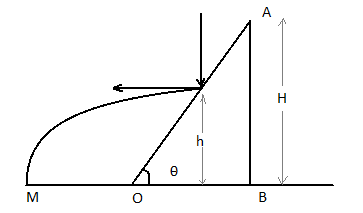
A body falling freely from a given height $H$ hits an inclined plane in its path at a height. As a result of this impact the direction of the velocity of the body becomes horizontal. For what value of $\left( {\dfrac{h}{H}} \right)$ body will take a maximum time to reach the ground.
A) $\dfrac{1}{3}$
B) $\dfrac{1}{2}$
C) $\dfrac{2}{5}$
D) $\dfrac{2}{3}$
Answer
220.8k+ views
Hint: To find the answer for the given solution, first we need to draw a reference diagram and then we should find the total time taken by the body to fall. From this we can calculate the value of $\left( {\dfrac{h}{H}} \right)$ in which the body will take a maximum time to reach the ground.
Complete step by step solution:

From above diagram the body which falls from height $H$ from the point $B$ from $h$ height above the ground. The path of the body after striking it will be like a parabola.
Then the time taken by the body to fall A to B is ${t_1}$.
$ \Rightarrow \left( {H - h} \right) = \dfrac{1}{2}g{t_1}^2$
$ \Rightarrow {t_1} = \sqrt {\dfrac{{2\left( {H - h} \right)}}{g}} $
The time taken by the body which falls from B to M is ${t_2}$.
$ \Rightarrow h = \dfrac{1}{2}g{t_2}^2$
$ \Rightarrow {t_2} = \sqrt {\dfrac{{2h}}{g}} $
Then the total time taken by the body to fall,
$ \Rightarrow T = {t_1} + {t_2}$
$ \Rightarrow T = \sqrt {\dfrac{{2(H - h)}}{g}} + \sqrt {\dfrac{{2h}}{g}} $
By taking the common elements out then the equation is,
$ \Rightarrow T = \sqrt {\dfrac{2}{g}[(H - h)^{1/2} +{h}^{1/2}]} $
If the body reaches the maximum height then $\dfrac{{dt}}{{dh}} = 0$
We need to differentiate the above equation with respect to $h$we get,
$\dfrac{1}{2}{(H - h)^{\dfrac{{ - 1}}{2}}}( - 1) + \dfrac{1}{2}{h^{\dfrac{{ - 1}}{2}}} = 0$
$ \Rightarrow H - h = h$
$ \Rightarrow H = h + h$
$ \Rightarrow H = 2h$
$ \Rightarrow \dfrac{h}{H} = \dfrac{1}{2}$
Then the value of $\dfrac{h}{H}$ in which the body takes the maximum time to reach the ground is $\dfrac{1}{2}$.
Therefore the option (B) is correct.
Note: The above problem is based on kinematics that is motion in a straight line. The kinematics are used in day to day life everywhere, kinematics is a kind of mechanism in which dynamics can concern the forces. The main application of the kinematics is used in astrophysics that is robotics, biomechanics and also in mechanical engineering. Because it is used to describe the motion of the system to joint parts.
Complete step by step solution:

From above diagram the body which falls from height $H$ from the point $B$ from $h$ height above the ground. The path of the body after striking it will be like a parabola.
Then the time taken by the body to fall A to B is ${t_1}$.
$ \Rightarrow \left( {H - h} \right) = \dfrac{1}{2}g{t_1}^2$
$ \Rightarrow {t_1} = \sqrt {\dfrac{{2\left( {H - h} \right)}}{g}} $
The time taken by the body which falls from B to M is ${t_2}$.
$ \Rightarrow h = \dfrac{1}{2}g{t_2}^2$
$ \Rightarrow {t_2} = \sqrt {\dfrac{{2h}}{g}} $
Then the total time taken by the body to fall,
$ \Rightarrow T = {t_1} + {t_2}$
$ \Rightarrow T = \sqrt {\dfrac{{2(H - h)}}{g}} + \sqrt {\dfrac{{2h}}{g}} $
By taking the common elements out then the equation is,
$ \Rightarrow T = \sqrt {\dfrac{2}{g}[(H - h)^{1/2} +{h}^{1/2}]} $
If the body reaches the maximum height then $\dfrac{{dt}}{{dh}} = 0$
We need to differentiate the above equation with respect to $h$we get,
$\dfrac{1}{2}{(H - h)^{\dfrac{{ - 1}}{2}}}( - 1) + \dfrac{1}{2}{h^{\dfrac{{ - 1}}{2}}} = 0$
$ \Rightarrow H - h = h$
$ \Rightarrow H = h + h$
$ \Rightarrow H = 2h$
$ \Rightarrow \dfrac{h}{H} = \dfrac{1}{2}$
Then the value of $\dfrac{h}{H}$ in which the body takes the maximum time to reach the ground is $\dfrac{1}{2}$.
Therefore the option (B) is correct.
Note: The above problem is based on kinematics that is motion in a straight line. The kinematics are used in day to day life everywhere, kinematics is a kind of mechanism in which dynamics can concern the forces. The main application of the kinematics is used in astrophysics that is robotics, biomechanics and also in mechanical engineering. Because it is used to describe the motion of the system to joint parts.
Recently Updated Pages
Two discs which are rotating about their respective class 11 physics JEE_Main

A ladder rests against a frictionless vertical wall class 11 physics JEE_Main

Two simple pendulums of lengths 1 m and 16 m respectively class 11 physics JEE_Main

The slopes of isothermal and adiabatic curves are related class 11 physics JEE_Main

A trolly falling freely on an inclined plane as shown class 11 physics JEE_Main

The masses M1 and M2M2 M1 are released from rest Using class 11 physics JEE_Main

Trending doubts
JEE Main 2026: Application Form Open, Exam Dates, Syllabus, Eligibility & Question Papers

Derivation of Equation of Trajectory Explained for Students

Hybridisation in Chemistry – Concept, Types & Applications

Understanding the Angle of Deviation in a Prism

How to Convert a Galvanometer into an Ammeter or Voltmeter

Degree of Dissociation: Meaning, Formula, Calculation & Uses

Other Pages
Thermodynamics Class 11 Physics Chapter 11 CBSE Notes - 2025-26

JEE Advanced Marks vs Ranks 2025: Understanding Category-wise Qualifying Marks and Previous Year Cut-offs

Units And Measurements Class 11 Physics Chapter 1 CBSE Notes - 2025-26

NCERT Solutions For Class 11 Physics Chapter 8 Mechanical Properties Of Solids

Motion in a Straight Line Class 11 Physics Chapter 2 CBSE Notes - 2025-26

Laws of Motion Class 11 Physics Chapter 4 CBSE Notes - 2025-26




